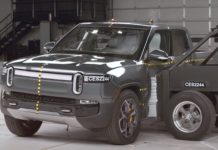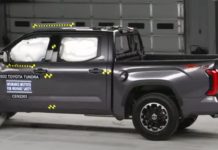
The IIHS ran a key crash test on several EVs, including the Tesla Cybertruck and Ford F-150 Lightning.
Every year, the Insurance Institute for Highway Safety ratchets up the difficulty for its various safety tests, whether its crashworthiness or mitigation technologies like automatic emergency braking. One of the latest updates to the battery of crash tests includes the moderate frontal overlap evaluation, where vehicles strike a stationary barrier at 40 mph with 40% of the front end overlapping the barrier. Among a set of seven new electric vehicles taking on the tests necessary to get the IIHS’ “Top Safety Pick” accolade, two trucks took part. Can you guess whether the Ford F-150 Lightning or the Tesla Cybertruck came out ahead on crashworthiness?
If you guessed the F-150, you’re…wrong, actually. While Ford’s immensely popular pickup scored well for the 2024 model year, earning a Top Safety Pick award, neither it nor its electric platform-mate, the F-150 Lightning, did as well in the updated moderate overlap test, which the IIHS initially implemented back in 2022.


Why? Because while the updated evaluation runs at the same speed as the original test and uses the same proportion of a vehicle’s front end, it only took into account potential injuries to an average-sized male dummy in the driver’s seat. The new test, on the other hand, brings rear-seat passengers into the equation, in the form of a dummy the size of a small woman or 12-year-old positioned in the passenger seat. Injuries to the rear-seat dummy, including moderate risks of injury to the head, neck and chest in the event of a front-end crash, earned the F-150 Lightning a ‘Poor’ rating overall. The IIHS notes the shoulder belt moved too far upward toward the dummy’s neck during the crash, and the lap belt moved as well, compromising the rear restraint’s effectiveness at controlling the dummy’s movement.
The Tesla Cybertruck, on the other hand, performed far better in this test than the Lightning. Not only did the front passenger fare well, scoring ‘Good’ ratings (or lower risk of injury to bodily areas) across the board, but so did the more vulnerable rear passenger. The IIHS noted an elevated risk of chest injury (rated ‘Acceptable’), but the dummy did not hit the front seatback, and the seatbelts remained in an ideal position.
Look at headlights, however, and the shoe is on the other foot.
As far as each truck’s crashworthiness is concerned, it’s worth noting the IIHS only published the moderate front crash test results for 2025 models so far. In a full battery of tests, the IIHS also looks at a small overlap frontal crash results (where a smaller portion of the front end has to handle extreme impact forces), as well as side impacts. We don’t have either of those for the 2025 Ford F-150 Lightning or Tesla Cybertruck just yet.
The IIHS did rate headlight performance, however. Their test looks at low beams as well as high beams, on straightaways as well as in two increasingly tight curves. Vehicles have to pass certain thresholds to score a Good rating, and the Tesla Cybertruck…doesn’t. While it’s easy to take the ‘Poor’ result and say the Tesla’s headlights suck, the answer is a bit more nuanced than that. In fact, the agency didn’t criticize the headlights’ performance — visibility is typically good for the driver in most situations — but for excessive glare the low-beams create for other motorists.
Ford’s F-150 Lightning, on the other hand, scored an Acceptable rating because they didn’t exceed the IIHS’ glare limits. That said, visibility was an issue for both the low- and high-beams. Both trucks scored some extra credit for having standard high-beam assist, which compensates for some of the headlights’ limitations since they ideally result in better visibility than the driver just keeping the low-beams on most of the time.
The IIHS praised Ford’s seat belt reminder functionality, as well. It criticized Tesla’s, largely for alerts being too short on startup, when a belt is disengaged or if an occupant is unbelted in the first place while the vehicle’s moving. If you’re shopping either one of these trucks with small kids, however, the Tesla Cybertruck did score better on child seat anchor ease-of-use than the F-150 Lightning. That’s typically an area where trucks struggle, and these two are no exception.
Still, whatever you may think of the Tesla Cybertruck, it did perform well in this crashworthiness test conducted by the IIHS. The F-150 Lightning, by virtue of being on the older T3 platform as the gas F-150s, may fare better once it gets a redesign.
At the moment, the IIHS hasn’t published results for other large electric trucks like the Chevy Silverado EV/GMC Sierra EV or the GMC Hummer EV. It has tested the Rivian R1T, however, with that (admittedly smaller) truck actually nabbing a Top Safety Pick nod for 2025. At the moment, it’s the only electric truck to do so, and one of the few trucks period to do it for 2025. (Right now, the best-performing truck in IIHS safety tests is the Toyota Tundra, which earned Top Safety Pick+ for 2025.)

















![Which is More Reliable: 3.5L EcoBoost or 5.0L V8? [Reader Question] Second-generation 3.5-liter EcoBoost engine](https://tfltruck.com/wp-content/uploads/2016/05/Second-generation-35-liter-EcoBoost-engine.jpg)
![Which Silverado Engine to Get: 5.3L or 6.2L V8? [Ask TFLTruck] 2016 chevy silverado](https://tfltruck.com/wp-content/uploads/2015/10/2016-chevy-silverado-grille.jpg)
